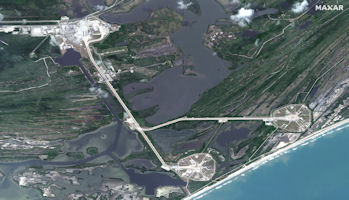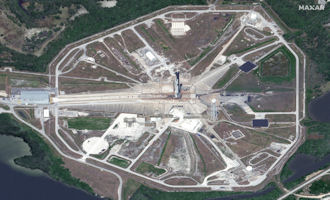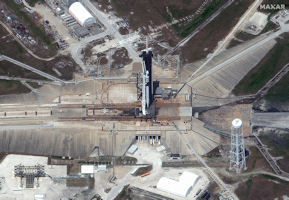Launch Complex 39 / LC-39
Kennedy Space Center (KSC) is NASA’s Launch Operations Center supporting Launch Complex 39 (LC-39) originally built for the Saturn V, the largest and most powerful operational launch vehicle in history, for the Apollo program. Since the Apollo program, LC-39 has been used to launch every NASA human spaceflight including Skylab, the Apollo-Soyuz Test Project, and the Space Shuttle Program. Most recently, SpaceX signed an agreement with NASA to lease Launch Complex 39A for the Falcon Heavy, and the company began modifying the facility in 2014.
SpaceX launches the Falcon 9 and Falcon Heavy from LC-39A, which previously supported Space Shuttle launches. SpaceX also launches the Falcon 9 from LC-40 at CCAFS. LC-39A construction was started in 1965 and completed in 1966 to support the Apollo Program. Both LC-39A and LC-39B were later modified for the Shuttle Program. NASA prepared an EA in 2013 to increase KSC spaceport capabilities and allow both commercial and governmental entities to use LC-39A and LC-39B for launch purposes involving a variety of vertical launch vehicles, including Falcon launch vehicles.
In 2014, NASA granted a lease to SpaceX to operate at LC-39A and construct a horizontal integration facility. Additional components of SpaceX activities at LC-39A were reviewed by NASA via KSC’s Environmental Checklist and Record of Environmental Consideration process. SpaceX successfully launched the first of several Falcon 9 v1.1 launch vehicles at LC-39A on February 19, 2017 and, as of October 2019, there have been 18 total launches. The Falcon Heavy launched for the first time on February 6, 2018 and again on April 11, 2019 and June 25, 2019, all from LC-39A. In a 2016 Programmatic Environmental Impact Statement (EIS), NASA identified potential environmental impacts associated with proposed operations, activities, and facilities at KSC over a 20-year period, including at LC-39A.
Engineers had planned to transform Kennedy's launch infrastructure to support the SLS rocket and Orion spacecraft. The heavy-lift rocket was to be stacked in the Vehicle Assembly Building on the mobile launcher and roll out to Launch Pad 39B atop a modified crawler transporter. The Orion spacecraft will be fueled with propellants in the Multi-Payload Processing Facility at Kennedy prior to stacking atop the rocket. The launch team was to use the new command and control system in the firing room as the clock counts down to liftoff of SLS’s first flight.
Launch Complex 39's Pad A and Pad B were originally designed to support the Apollo program and were modified for Space Shuttle launch operations. Major changes included the erection of a new Fixed Service Structure (FSS), addition of a Rotating Service Structure (RSS), and the replacement of the Saturn flame deflectors with three new flame deflectors. The upper portion of the Saturn V Launch umbilical tower was removed from two of the Apollo Mobile Launchers and installed at the pad to serve as the FSS.
Since the late 1960s, Pads A and B at Kennedy Space Center's Launch Complex 39 have served as backdrops for America's most significant manned space flight endeavors - Apollo, Skylab, Apollo-Soyuz and Space Shuttle.
Located on Merritt Island, Florida, just north of Cape Canaveral, the pads were originally built for the huge Apollo/Saturn V rockets that launched American astronauts on their historic journeys to the Moon and back. Following the joint U.S.-Soviet Apollo-Soyuz Test Project mission of July 1975, the pads were modified to support Space Shuttle operations.
Both pads were designed to support the concept of mobile launch operations, in which space vehicles are assembled and checked out in the protected environment of the Vehicle Assembly Building, then transported by large tracked vehicles to the launch pad for final processing and launch. During the Apollo era, key pad service structures were mobile. For the Space Shuttle, two permanent service towers were installed at each pad for the first time, the Fixed Service Structure and the Rotating Service Structure.
On April 12, 1981, Shuttle operations commenced at Pad A with the launch of Columbia on STS-1. After 23 more successful launches from A, the first Space Shuttle to lift off from Pad B was the ill-fated Challenger in January 1986. Pad B was designated for the resumption of Shuttle flights in September 1988, followed by the reactivation of Pad A in January 1990.
Fuel, oxidizer, high pressure gas, electrical, and pneumatic lines connect the Shuttle vehicle with ground support equipment and are routed through the FSS, RSS and Mobile Launch Platform.
Space Shuttle access and servicing at the pad are provided by:
- FSS - Gaseous Hydrogen Vent Arm for electrical power and for venting hydrogen from the external tank.
- RSS - Mid-Body Umbilical Unit for fuel cell servicing and life support functions.
- RSS facilities for loading and off-loading payloads.
- Hypergolic Umbilical System for servicing the Orbiter systems with fluids and gases.
- Gaseous Oxygen Vent Arm for preventing ice formation atop the external tank.
- Orbiter Access Arm (OAA) for crew entrance and exit.
- MLP - Tail Service Masts for propellant loading and electrical power.
The FSS is topped by a 24.4 meter (80ft) tall fiberglass lightning mast grounded by 335 meter (1,100ft) cables that are anchored north and south of the pad. The Mast provides lightning protection for pad structures and the Space Shuttle.
The RSS accommodates the loading of payloads vertically at the pad. It is mounted on a semi-circular track which allows it to rotate through an arc of 120 degrees on a radius of 36.6 meters (120 ft). The RSS pivots from a hinge on the FSS until the RSS spacecraft changeout room fits flush with the Orbiters's cargo bay. This room allows payloads to be installed or serviced under contamination-free or "clean room" conditions.
Blast-protected hypergolic storage and supply systems are provided at each pad, and the Launch Processing System (LPS) is used to monitor all aspects of vehicle and payload operations. The LPS system interconnects to the MLP through Hardware Interface Modules (HIM's) located in Pad Terminal Connection Rooms beneath the pads.
Pads 39-A and 39-B are virtually identical and roughly octagonal in shape. The distance between pads is 2,657 meters (8,715 ft). The pad base contains 52,000 cubic meters (68,000 cubic yards) of concrete. The ramp leading up to the pad is inclined at a 5% grade. The flame trench is 13 meters (42 ft) deep, 137 meters (450ft) long and 18 meters (58 ft) wide. The orbiter flame deflector is 11.6 meters (38ft) high, 22 meters (72 ft) long and 17.5 meters (57.6 ft) wide. It weights 590,000 kg (1.3 million lbs). The SRB deflector is 12.95 meters (42.5 ft) high, 12.8 meters (42 ft) long and 17.4 meters (57 ft) wide. It weights 499,000 kg (1.1 million lbs). The Sound Suppression Water System is used to protect the launch structure from the intense sound pressure of liftoff. Its water tank is 88.9 meters (290ft) high and has a capacity of 1,135,000 liters (300,000 gallons).
There are 6 permanent and 4 extensible pedestals that are used to support the MLP at the pad. Dynamic loads at rebound are 3,175,200 kg (7,000,000 lbs) to 4,762,800 kg (10,500,000lb) at liftoff. The pad is lit with 5 clusters of Xenon high-intensity searchlights (total searchlights: 40) around the pad perimeter.
The height of the Fixed Service Structure (FSS) is 105.7 meters (347ft) to the top of the lightning mast (referenced to the pad base) and the Rotating Service Structure (RSS) is 57.6 meters (189ft) high. The Fixed Service Structure (FSS) and Rotating Service Structure (RSS) on Pad 39A underwent a renovation between June and September 1993. Some 13,773 gallons of paint were used on two coats and 1,866 tons of sand were used in the sandblasting operation.
The LC-39 Launch complex also contains large liquid oxygen (LOX) and Liquid Hydrogen (LH2) storage tanks. These are large ball-shaped vacuum jacketed dewar bottles used to store supercold cryogenic propellants for the shuttle external tank. The LOX tank, located at the northwest corner of the pad stores 3,406,500 liters (900,000 gallons) of liquid oxygen at a temperature of minus 183 degress C (-298 F). The LH2 tank is located at the northeast corner of the pad and stores 3,218,250 liters (850,000 gallons) of liquid hydrogen at a temperature of minus 253 degrees C (-423 degrees F).
The Weather Protection System protects orbiter tiles from wind blown debris, rain and hail. Wheeled metal doors that ride on steel beams are attached to the Rotating Service Structure and the Fixed Service Structure. Doors slide together (to within 3 inches of each other) between the orbiter's belly and the external tank, providing protection for the lower portion of the orbiter.
The East Door, attached to the RSS measures 16 meters (53 ft) long, 8 meters (27 ft) tall and weighs 19 metric tons (42,000 lbs). The West Door, attached to the FSS measures 13 meters (43 ft) long, 11.6 meters (38ft) tall and weighs 21 metric tons (46,000 lbs)
The top of the orbiter is shielded by an inflatable seal extending from the Payload Changeout Room forming a semi-circle covering 90 degrees of arc between the orbiter and its external tank. The sides of the orbiter, between the vehicle and the external tank, are protected by a series of 20 metal bi-fold doors that fold out from the Payload Changeout Room. The doors measure 24.4 meters by 1.2 meters (80ft x 4ft). The launch pads are taken out of service every three to five years for maintenance and modifications. This "Mod Period" lasts six to nine months, during which several contractors are tasked with specific modifications. Some tasks completed in 2003 on Pad A were adding a new 5,000-square-foot operations building and computer-automating the Payload Ground Handling Mechanism (PGHM). The Pad A operations building is a mix of office and shop space, providing space for NASA, United Space Alliance and subcontractor personnel previously scattered around the complex. They include pad operations managers, quality and safety personnel, system engineers, planners and schedulers and shops for the cryogenic, hypergolic, electrical and environmental control systems. The building also houses personnel for payload, external tank/solid rocket boosters and Space Shuttle main engine operations at the pads. Consolidation of the personnel into one site has reduced maintenance requirements as well as increased efficiency and morale. The PGHM is used in the Payload Changeout Room on the Rotating Service Structure to remove payloads from a transportation canister and install them into the orbiter. Essentially NASAís largest forklift, the PGHM is now controlled by a single operator, compared to the previous method of two or three working hand controls. It has greater tolerance for accuracy. Other work has included upgrading Apollo-era electrical power systems, adding new safety tie-off points and performing corrosion control. Corrosion of metal structures are endemic to the waterside environment. The metal pad structures are stripped and repainted on a recurring basis. Sand blasting and repainting are best done during a Mod Period because they stop all other work and create a foreign object debris situation.
|
NEWSLETTER
|
| Join the GlobalSecurity.org mailing list |
|
|
|





